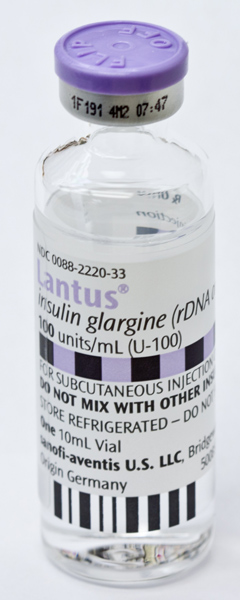Toujeo has a lower glucose lowering effect than Basaglar, Lantus, Rezvoglar, or Semglee on a unit-to-unit basis.
Basaglar, Lantus, Rezvoglar, or Semglee
- SC (Adults and Children ≥6 yr): Type 1 diabetes (insulin naive): 1/3 of the total daily insulin dose given once daily, then adjust on the basis of patient's needs (remainder of insulin dose should be given as a short-acting insulin) (usual starting total daily insulin dose = 0.2–0.4 units/kg); Type 2 diabetes (insulin naive): 0.2 units/kg or up to 10 units once daily; then adjust on the basis of patient's needs; Type 1 or 2 diabetes (and converting from Toujeo): Give 80% of Toujeo dose as Basaglar, Lantus, or Semglee once daily, then adjust on the basis of patient's needs; Type 1 or 2 diabetes (and converting from once daily NPH): Give the same dose once daily, then adjust on the basis of patient's needs; Type 1 or 2 diabetes (and converting from twice daily NPH): Give 80% of the total daily NPH dose once daily, then adjust on the basis of patient's needs.
Toujeo
- SC (Adults ): Type 1 diabetes (insulin naive): ⅓–½ of the total daily insulin dose given once daily, then adjust on the basis of patient's needs (range = 1–80 units/day), (remainder of insulin dose should be given as a short-acting insulin) (usual starting total daily insulin dose = 0.2–0.4 units/kg); Type 2 diabetes (insulin naive): 0.2 units/kg once daily, then adjust on the basis of patient's needs; Type 1 or 2 diabetes (and converting from intermediate or long-acting insulin): Use same total daily dose and give once daily, then adjust on the basis of patient's needs;Type 1 or 2 diabetes (and converting from NPH insulin): Use 80% of the total daily NPH and give once daily, then adjust on the basis of patient's needs.
Therapeutic Classification: hormones, antidiabetics
Pharmacologic Classification: pancreatics
Absorption: Provides slower prolonged absorption and a relatively constant concentrations over 24 hr.
Distribution: Identical to endogenous insulin.
Metabolism/Excretion: Partially metabolized at the site of injection to active insulin metabolites. Metabolized by liver, spleen, kidney, muscle.
Half-Life: 5–6 min (prolonged in diabetic patients; biological half-life is longer).
